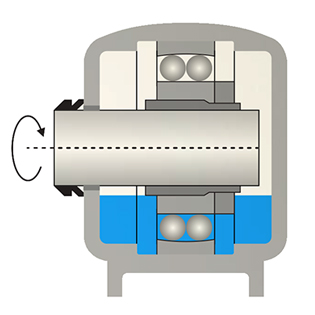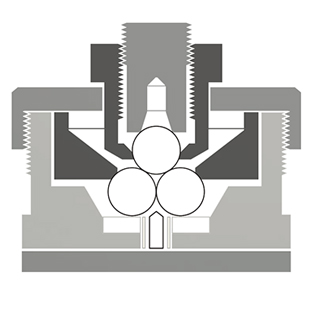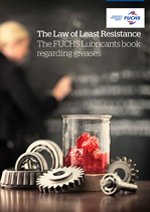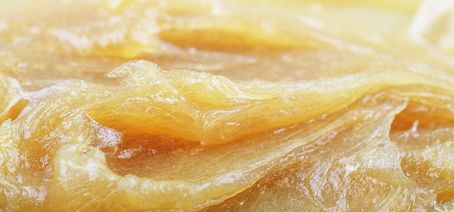Testing of greases – some common tests
Base oil viscosity
The viscosity of the base oil is perhaps the single most important property in all lubricants, including greases. The thickener and the base oil are what give a grease its lubrication properties, but it is mainly the base oil viscosity that determines the grease's lubrication capacity.
Viscosity depends both on temperature and pressure. The temperature is always stated when measuring viscosity, as viscosity decreases as the temperature rises. Viscosity is normally measured in terms of the time it takes for a standard quantity of fluid to flow out through a specific opening at a given temperature. Base oil viscosity is given as 'Kinematic viscosity' in mm²/s at 40°C and also at 100°C.
Method: ASTM D445, ISO 3104, DIN 51562, IP 71
Dropping point
When a grease is heated, it eventually reaches a temperature where the thickener has changed to such an extent that it can no longer keep the oil in place. The dropping point is the temperature at which the grease releases the first drop of oil. The parameter is measured using a standardized method whereby a container of the grease is heated in a furnace until the first drop of oil comes out of the container.
Many people wrongly believe that the dropping point is a measure of the grease's performance at high temperature. In fact, the dropping point says nothing about the grease's working properties, nor does it define some kind of upper temperature limit. It is more the fact that at temperatures above the dropping point, the grease is likely to produce more leakage. However, this also depends on whether the higher temperature can be assumed to be constant or is a temporary peak.
Method: ASTM D566, ISO 2176, DIN 51801, IP 396
Copper corrosion
Copper corrosion tests are used to determine the grease's ability to protect copper metals/yellow metals and other soft alloys sometimes found in bearings. A polished copper strip is exposed to the grease for a specific time at a specific temperature, usually 24 hours at 100 to 120°C. The strip is then cleaned, and the color is compared to the ASTM standard for grade determination. '1a' is the best rating on the scale.
Method: ASTM D4048, ISO 2160, DIN 51811, IP112/154

Cone penetration
By far the most common test for greases is cone penetration, which measures the grease's consistency. The grease is heated to 25°C and placed in a container. The grease is subjected to 60 strokes over 60 seconds. A standardized cone is allowed to sink under its own weight into the grease in the container, and the penetration distance is given in tenths of a millimeter. The higher the value, the softer the grease. The resulting value produces an NLGI* rating as per the table to the right. Greases rated NLGI 0 to 000 are often used in central lubrication systems. NLGI 2 is by far the most common consistency, while NLGI grades 3 to 6 are rare.
| NLGI rating | Consistency | Penetration mm/10 in 5 secs |
|---|---|---|
| 000 | Fluid | 475 – 445 |
| 00 | Semi-fluid | 430 – 400 |
| 0 | Very soft | 385 – 355 |
| 1 | Soft | 340 – 310 |
| 2 | 'Normal' grease | 295 – 265 |
| 3 | Firm | 250 – 220 |
| 4 | Very firm | 205 – 175 |
| 5 | Hard | 160 – 130 |
| 6 | Very hard | 115 – 85 |
Nowadays it is common to add a consistency rating between the various established NLGI ratings. These are designated by half values, such as 1.5 or 2.5.
Method: ASTM D217, ISO 2137 DIN 51580, IP 50
* NLGI = National Lubricating Grease Institute
Water resistance
Water resistance according to the water washout test is used to measure the grease's ability to remain in place in the bearing in wet conditions. A water jet is sprayed onto the bearing's housing at a flow of 5 ml/s at 79°C. After the test, the housing is opened and dried at 77°C for 15 hours. The result is the amount of washed-out grease. The higher the percentage of grease remaining in the bearing, the better its resistance to water washout.
Method: ASTM D1264, ISO 11009, DIN 51807/2, IP215

Corrosion protection
The EMCOR test is a dynamic test for evaluating the grease's corrosion protection capacity in a bearing. The test can be run with distilled water, synthetic salt water or a specific process water. A specially designed bearing is filled with the grease that is to be tested. The bearing is mounted onto a motor-driven shaft and placed in a closed housing which is sealed at one end (water must be able to pass through the bearing).
The bearing alternates between operational and stationary over a specific test cycle. The outer ring is then assessed on a scale of 1 to 5, where 0 = no corrosion and 5 = heavy corrosion.
Method: ISO 11007
Load-bearing capacity
The 4-ball weld test is a method for measuring the maximum load-bearing capacity or EP/extreme pressure properties of a grease. At the weld point, the maximum load the grease can withstand has been exceeded and the grease no longer provides any lubrication. It can be hard to compare results from different test methods.
The test entails filling a container with grease. Three clean steel balls are sunk into the grease and locked into place with a ring and nut. The fourth ball is mounted into the machine above the three others. A given weight burdens the torque arm to produce a specific pressure. The top ball rotates at 1420 rpm for 60 seconds and the test is repeated with increased load until the balls weld together. The result is given in Newtons, N.

Wear-resistance
The 4-ball wear test is used as a method of measuring the grease's ability to prevent wear under demanding conditions. The grease's wear resistance is examined in sliding contacts steel on steel. The test is set up the same as the 4-ball weld test, but with a limited load and more sensitive equipment. Once the test is complete, the size of the wear marks on the three stationary balls is measured. The lower the value, the better the grease's wear resistance under dynamic strain.
Method: ASTM D2266, DIN 51350, IP 239

More about grease

Handbook
The Law of Least Resistance - The FUCHS LUBRICANTS book regarding greases.
